Electrical and Optical Characterization of SAW Sensors Coated with Parylene C and Their Analysis Using the Coupling-of-Modes (COM) Theory
Abstract
:1. Introduction
2. Test Samples and Experimental Setup
3. Electrical Sensor Characterization
4. Optical Attenuation Measurement with LDV
5. Sound Velocity Measurements
6. Validation of Experimental Data for COM Model Analysis
6.1. Modification to COM Parameters Due to Polymer Coating
6.2. Extraction of COM Parameters from Measurements and Numerical Simulations
7. Insight into Crosstalk Decrease
8. Discussion
8.1. Frequency Shift and Sound Velocity Modification
8.2. Insertion and Propagation Loss
8.3. Static Capacity Modification
8.4. Crosstalk Decrease
9. Conclusions
Supplementary Materials
Author Contributions
Funding
Institutional Review Board Statement
Informed Consent Statement
Data Availability Statement
Acknowledgments
Conflicts of Interest
Abbreviations
| SAW | surface acoustic wave |
| COM | coupling-of-modes |
| VNA | vector network analyzer |
| LDV | laser Doppler vibrometry |
| FEMSDA | finite element method and spectral domain analysis |
References
- Ma, Z.; Huang, Q.; Xu, Q.; Zhuang, Q.; Zhao, X.; Yang, Y.; Qiu, H.; Yang, Z.; Wang, C.; Chai, Y.; et al. Permeable superelastic liquid-metal fibre mat enables biocompatible and monolithic stretchable electronics. Nat. Mater. 2021, 20, 859–868. [Google Scholar] [CrossRef] [PubMed]
- Herth, E.; Guerchouche, K.; Rousseau, L.; Calvet, L.E.; Loyez, C. A biocompatible and flexible polyimide for wireless sensors. Microsyst. Technol. 2017, 23, 5921–5929. [Google Scholar] [CrossRef]
- Mariello, M.; Fachechi, L.; Guido, F.; De Vittorio, M. Conformal, Ultra-thin Skin-Contact-Actuated Hybrid Piezo/Triboelectric Wearable Sensor Based on AlN and Parylene-Encapsulated Elastomeric Blend. Adv. Funct. Mater. 2021, 31, 2101047. [Google Scholar] [CrossRef]
- Appusamy, S.; Krishnan, S.; Gopikrishna, M.; Raman, S. Bio-based Materials for Microwave Devices: A Review. J. Electron. Mater. 2021, 50, 1893–1921. [Google Scholar] [CrossRef]
- Cointe, C.; Laborde, A.; Nowak, L.G.; Arvanitis, D.N.; Bourrier, D.; Bergaud, C.; Maziz, A. Scalable batch fabrication of ultrathin flexible neural probes using a bioresorbable silk layer. Microsyst. Nanoeng. 2022, 8, 21. [Google Scholar] [CrossRef]
- Losada, P.G.; Rousseau, L.; Grzeskowiak, M.; Valet, M.; Nguyen, D.; Dégardin, J.; Dubus, E.; Picaud, S.; Lissorgues, G. Protuberant electrode structures for subretinal electrical stimulation: Modeling, fabrication and in vivo evaluation. Front. Neurosci. 2019, 13, 885. [Google Scholar] [CrossRef] [Green Version]
- Sharafkhani, N.; Kouzani, A.Z.; Adams, S.D.; Long, J.M.; Lissorgues, G.; Rousseau, L.; Orwa, J.O. Neural tissue-microelectrode interaction: Brain micromotion, electrical impedance, and flexible microelectrode insertion. J. Neurosci. Methods 2022, 365, 109388. [Google Scholar] [CrossRef]
- Sharifi, H.; Lahiji, R.R.; Lin, H.C.; Peide, D.Y.; Katehi, L.P.; Mohammadi, S. Characterization of Parylene-N as flexible substrate and passivation layer for microwave and millimeter-wave integrated circuits. IEEE Trans. Adv. Packag. 2009, 32, 84–92. [Google Scholar] [CrossRef]
- Golda-Cepa, M.; Engvall, K.; Hakkarainen, M.; Kotarba, A. Recent progress on parylene C polymer for biomedical applications: A review. Prog. Org. Coat. 2020, 140, 105493. [Google Scholar] [CrossRef]
- Fu, C.; Elmazria, O.; Sarry, F.; Mahalingam, T.; Yang, S.S.; Lee, K. Development of wireless, batteryfree gyroscope based on one-port SAW delay line and double resonant antenna. Sens. Actuators A Phys. 2014, 220, 270–280. [Google Scholar] [CrossRef]
- Bongrain, A.; Rousseau, L.; Valbin, L.; Madaoui, N.; Lissorgues, G.; Verjus, F.; Chapon, P. A new technology of ultrathin AlN piezoelectric sensor for pulse wave measurement. Procedia Eng. 2015, 120, 459–463. [Google Scholar] [CrossRef] [Green Version]
- Herth, E.; Valbin, L.; Lardet-Vieudrin, F.; Algré, E. Modeling and detecting response of micromachining square and circular membranes transducers based on AlN thin film piezoelectric layer. Microsyst. Technol. 2017, 23, 3873–3880. [Google Scholar] [CrossRef]
- Diab, D.; Smagin, N.; Lefebvre, F.; Nassar, G.; Isber, S.; El Omar, F.; Naja, A. Broadband Vibrational Energy Harvesting with a Spherical Piezoelectric Transducer Devoted to Underwater Wireless Sensor Networks. Acta Acust. United Acust. 2019, 105, 616–629. [Google Scholar] [CrossRef]
- Rabus, D.; Friedt, J.M.; Ballandras, S.; Martin, G.; Carry, E.; Blondeau-Patissier, V. A high sensitivity open loop electronics for gravimetric acoustic wave-based sensors. In Proceedings of the EFTF-2010 24th European Frequency And Time Forum, Noordwijk, The Netherlands, 13–16 April 2010; pp. 1–7. [Google Scholar] [CrossRef]
- Para Tech Coating, Inc. Parylene Properties Chart; Para Tech Coating, Inc.: Aliso Viejo, CA, USA, 2010. [Google Scholar]
- Avramescu, V.; Bostan, C.; Serban, B.; Georgescu, I.; Costea, S.; Varachiu, N.; Cobianu, C. Surface Acoustic Wave devices and their sensing capabilities. In Proceedings of the 2009 International Semiconductor Conference, San Antonio, TX, USA, 11–14 October 2009; Volume 1, pp. 27–36. [Google Scholar] [CrossRef]
- Wohltjen, H.; Dessy, R. Surface acoustic wave probe for chemical analysis. I. Introduction and instrument description. Anal. Chem. 1979, 51, 1458–1464. [Google Scholar] [CrossRef]
- Grate, J.W.; Martin, S.J.; White, R.M. Acoustic Wave Microsensors. Anal. Chem. 1993, 65, 940A–948A. [Google Scholar] [CrossRef]
- Barié, N.; Wessa, T.; Bruns, M.; Rapp, M. Love waves in SiO2 layers on STW-resonators based on LiTaO3. Talanta 2004, 62, 71–79. [Google Scholar] [CrossRef]
- Avramov, I.; Rapp, M.; Kurosawa, S.; Krawczak, P.; Radeva, E. Gas sensitivity comparison of polymer-coated SAW and stw resonators operating at the same acoustic wave length. In Proceedings of the 2001 IEEE International Frequncy Control Symposium and PDA Exhibition (Cat. No.01CH37218), Seattle, DC, USA, 6–8 June 2001; pp. 465–473. [Google Scholar] [CrossRef]
- Avramov, I.; Lange, K.; Rupp, S.; Rapp, B.; Rapp, M. Polymer coating behavior of Rayleigh-SAW resonators with gold electrode structure for gas sensor applications. IEEE Trans. Ultrason. Ferroelectr. Freq. Control 2007, 54, 157–166. [Google Scholar] [CrossRef]
- Vanotti, M.; Blondeau-Patissier, V.; Moutarlier, V.; Ballandras, S. Analysis of palladium and yttrium–palladium alloy layers used for hydrogen detection with SAW device. Sens. Actuators B Chem. 2015, 217, 30–35. [Google Scholar] [CrossRef]
- Martin, S.J.; Frye, G.C.; Senturia, S.D. Dynamics and Response of Polymer-Coated Surface Acoustic Wave Devices: Effect of Viscoelastic Properties and Film Resonance. Anal. Chem. 1994, 66, 2201–2219. [Google Scholar] [CrossRef]
- Kondoh, J.K.J.; Shiokawa, S.S.S.; Rapp, M.R.M.; Stier, S.S.S. Simulation of Viscoelastic Effects of Polymer Coatings on Surface Acoustic Wave Gas Sensor under Consideration of Film Thickness. Jpn. J. Appl. Phys. 1998, 37, 2842. [Google Scholar] [CrossRef]
- Ippolito, S.; Kalantar-Zadeh, K.; Powell, D.; Wlodarski, W. A 3-dimensional finite element approach for simulating acoustic wave propagation in layered SAW devices. In Proceedings of the IEEE Symposium on Ultrasonics, Honolulu, HI, USA, 5–8 October 2003; Volume 1, pp. 303–306. [Google Scholar] [CrossRef]
- Kshetrimayum, R. Coupling-of-modes analysis and modeling of polymer-coated surface acoustic wave resonators for chemical sensors. IEEE Trans. Ultrason. Ferroelectr. Freq. Control 2012, 59, 1812–1819. [Google Scholar] [CrossRef] [PubMed]
- Herth, E.; Lardet-Vieudrin, F.; Valbin, L.; Algré, E. Detecting response of square and circular Si/AlN/Al membranes transducers by laser vibrometry Doppler and impedancemeter. In Proceedings of the 2015 Symposium on Design, Test, Integration and Packaging of MEMS/MOEMS (DTIP), Montpellier, France, 27–30 April 2015; IEEE: Piscataway, NJ, USA, 2015; pp. 1–5. [Google Scholar]
- Herth, E.; Zeggari, R.; Rauch, J.Y.; Remy-Martin, F.; Boireau, W. Investigation of amorphous SiOx layer on gold surface for Surface Plasmon Resonance measurements. Microelectron. Eng. 2016, 163, 43–48. [Google Scholar] [CrossRef]
- Herth, E.; Lardet-Vieudrin, F.; Deux, F.; Valbin, L.; Algré, E.; Schell, J.; Steger, H. Detection of out-of-plane and in-plane (XYZ) motions of piezoelectric microcantilever by 3D-Laser Doppler Vibrometry. In Proceedings of the 2016 Symposium on Design, Test, Integration and Packaging of MEMS/MOEMS (DTIP), Budapest, Hungary, 30 May–June 2016; IEEE: Piscataway, NJ, USA, 2016; pp. 1–4. [Google Scholar]
- White, R.M.; Voltmer, F.W. Direct piezoelectric coupling to surface elastic waves. Appl. Phys. Lett. 1965, 7, 314–316. [Google Scholar] [CrossRef]
- Hashimoto, K.y. Surface Acoustic Wave Devices in Telecommunications; Springer: Berlin/Heidelberg, Germany, 2000. [Google Scholar] [CrossRef]
- Ballantine, D.S. (Ed.) Acoustic Wave Sensors: Theory, Design, and Physico-Chemical Applications; Applications of Modern Acoustics; Academic Press: San Diego, CA, USA, 1997. [Google Scholar]
- Slobodnik, A.J. Materials and their influence on performance. In Acoustic Surface Waves; Amelinckx, S., Chebotayev, V.P., Gomer, R., Ibach, H., Letokhov, V.S., Lotsch, H.K.V., Queisser, H.J., Schäfer, F.P., Seeger, A., Shimoda, K., et al., Eds.; Series Title: Topics in Applied Physics; Springer: Berlin/Heidelberg, Germany, 1978; Volume 24, pp. 225–303. [Google Scholar] [CrossRef]
- Vanotti, M.; Blondeau-Patissier, V.; Rauch, J.Y.; Rabus, D.; Mazal, B.; Ballandras, S. SAW sensor exploiting palladium layer properties for selective detection of hydrogen. In Proceedings of the 2013 Joint European Frequency and Time Forum & International Frequency Control Symposium (EFTF/IFC), Prague, Czech Republic, 21–25 July 2013; IEEE: Piscataway, NJ, USA, 2013; pp. 775–778. [Google Scholar] [CrossRef]
- Smagin, N.; Djoumi, L.; Herth, E.; Vanotti, M.; Fall, D.; Blondeau-Patissier, V.; Duquennoy, M.; Ouaftouh, M. Fast time-domain laser Doppler vibrometry characterization of surface acoustic waves devices. Sens. Actuators A Phys. 2017, 264, 96–106. [Google Scholar] [CrossRef]
- Fall, D.; Duquennoy, M.; Ouaftouh, M.; Smagin, N.; Piwakowski, B.; Jenot, F. Non-destructive characterization of surfaces and thin coatings using a large-bandwidth interdigital transducer. Rev. Sci. Instrum. 2018, 89, 124901. [Google Scholar] [CrossRef]
- Parker, T. Precision Surface Acoustic Wave (SAW) Oscillators. In Proceedings of the 1982 Ultrasonics Symposium, San Diego, CA, USA, 27–29 October 1982; pp. 268–274. [Google Scholar] [CrossRef]
- Stone, D.C.; Thompson, M. Interdigital capacitance and surface acoustic wave sensors. Anal. Chem. 1993, 65, 352–362. [Google Scholar] [CrossRef]
- Thomas, R.; Johannes, T.; Ruile, W.; Weigel, R. Determination of phase velocity and attenuation of surface acoustic waves with improved accuracy. In Proceedings of the 1998 IEEE Ultrasonics Symposium. Proceedings (Cat. No. 98CH36102), Sendai, Japan, 5–8 October 1998; Volume 1, pp. 277–282. [Google Scholar] [CrossRef]
- Fourez, S.; Jenot, F.; Ouaftouh, M.; Duquennoy, M.; Ourak, M. Non-contact thickness gauging of a thin film using surface waves and a void effect on their propagation. Meas. Sci. Technol. 2012, 23, 085608. [Google Scholar] [CrossRef]
- Lefevre, F.; Jenot, F.; Ouaftouh, M.; Duquennoy, M.; Ourak, M. Laser generated guided waves and finite element modeling for the thickness gauging of thin layers. Rev. Sci. Instrum. 2010, 81, 034901. [Google Scholar] [CrossRef]
- Ambrozinski, L.; Piwakowski, B.; Stepinski, T.; Uhl, T. Evaluation of dispersion characteristics of multimodal guided waves using slant stack transform. NDT&E Int. 2014, 68, 88–97. [Google Scholar] [CrossRef]
- Askari, R.; Hejazi, S.H. Estimation of surface-wave group velocity using slant stack in the generalized S-transform domain. Geophysics 2015, 80, EN83–EN92. [Google Scholar] [CrossRef]
- Abraham, O.; Piwakowski, B.; Villain, G.; Durand, O. Non-contact, automated surface wave measurements for the mechanical characterisation of concrete. Constr. Build. Mater. 2012, 37, 904–915. [Google Scholar] [CrossRef]
- Kadi, T.; Duquennoy, M.; Fall, D.; Smagin, N.; Piwakowski, B.; Ouaftouh, M.; Jenot, F. Dimensional and mechanical characterization of metallic thin films based on the measurement of surface acoustic waves dispersion with Slant Stack transform. Meas. Sci. Technol. 2020, 31, 105009. [Google Scholar] [CrossRef]
- Fu, Q.; Stab, H.; Fischer, W.J. Wireless passive SAW sensors using single-electrode-type IDT structures as programmable reflectors. Sens. Actuators A Phys. 2005, 122, 203–208. [Google Scholar] [CrossRef]
- Plessky, V.; Koskela, J. Coupling-of-modes analysis of saw devices. Int. J. High Speed Electron. Syst. 2000, 10, 867–947. [Google Scholar] [CrossRef]
- Endoh, G.; Hashimoto, K.y.H.K.y.; Yamaguchi, M.Y.M. Surface Acoustic Wave Propagation Characterisation by Finite-Element Method and Spectral Domain Analysis. Jpn. J. Appl. Phys. 1995, 34, 2638. [Google Scholar] [CrossRef]
- Hashimoto, K.Y.; Zheng, G.; Yamaguchi, M. Fast analysis of SAW propagation under multi-electrode-type gratings with finite thickness. In Proceedings of the 1997 IEEE Ultrasonics Symposium Proceedings. An International Symposium (Cat. No.97CH36118), Toronto, ON, Canada, 5–8 October 1997; Volume 1, pp. 279–284. [Google Scholar] [CrossRef]
- Soluch, W. Design of SAW delay lines for sensors. Sens. Actuators A Phys. 1998, 67, 60–64. [Google Scholar] [CrossRef]
- Soluch, W. Admittance matrix of a surface acoustic wave interdigital transducer. IEEE Trans. Ultrason. Ferroelectr. Freq. Control 1993, 40, 828–831. [Google Scholar] [CrossRef]
- Wu, T.T.; Wang, S.M.; Chen, Y.Y.; Wu, T.Y.; Chang, P.Z.; Huang, L.S.; Wang, C.L.; Wu, C.W.; Lee, C.K. Inverse determination of coupling of modes parameters of surface acoustic wave resonators. Jpn. J. Appl. Phys. 2002, 41, 6610. [Google Scholar] [CrossRef]
- Rathod, V.T. A Review of Acoustic Impedance Matching Techniques for Piezoelectric Sensors and Transducers. Sensors 2020, 20, 4051. [Google Scholar] [CrossRef]
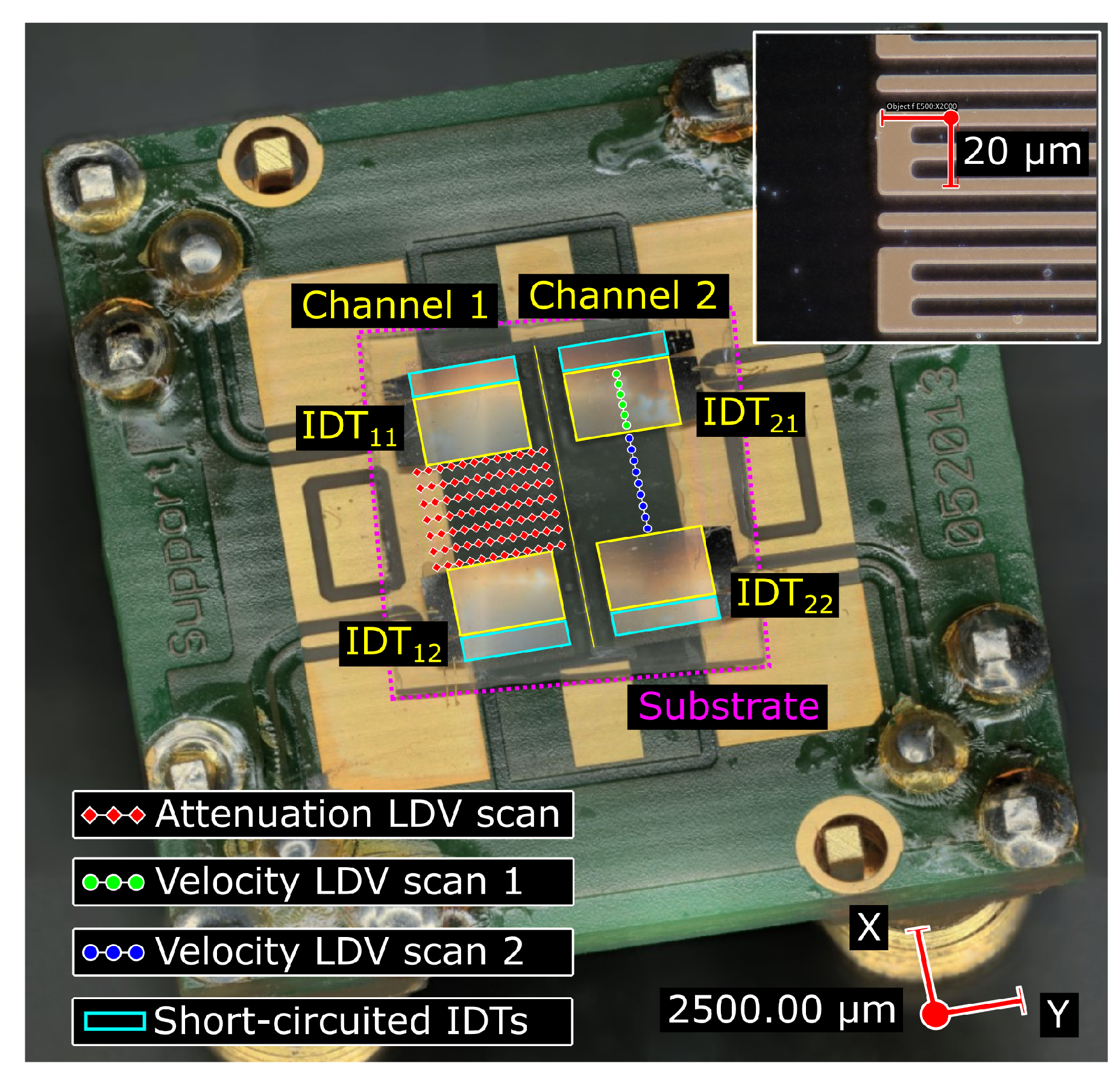
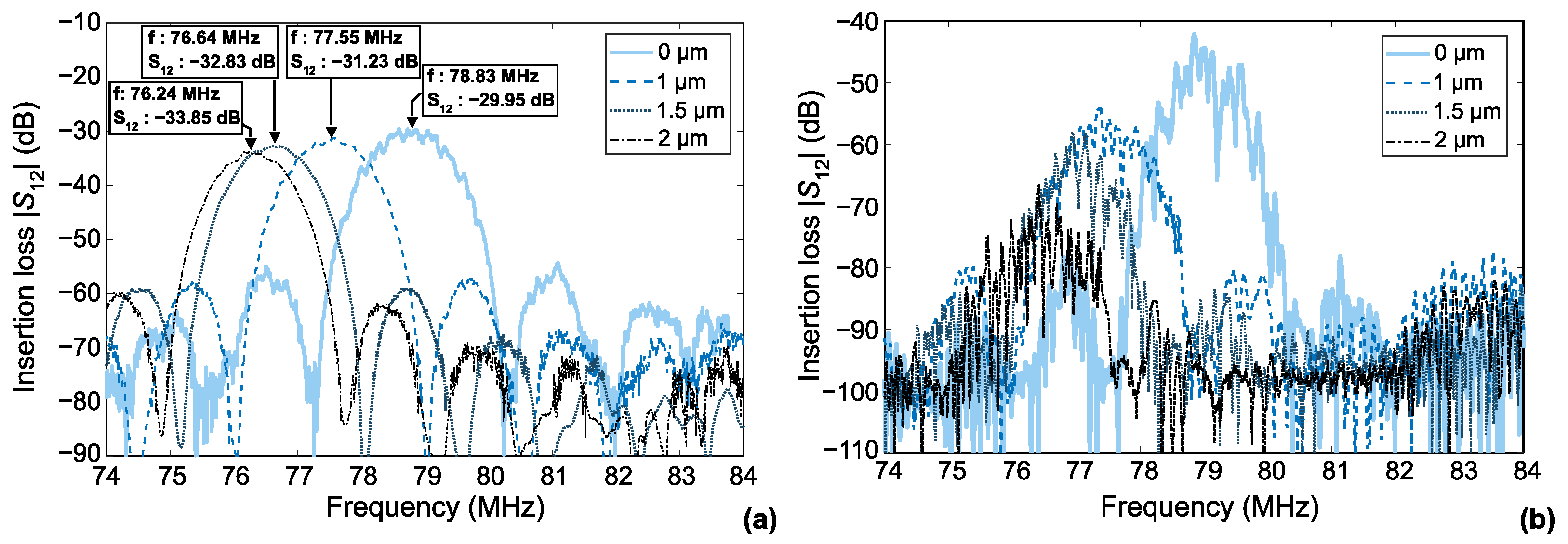
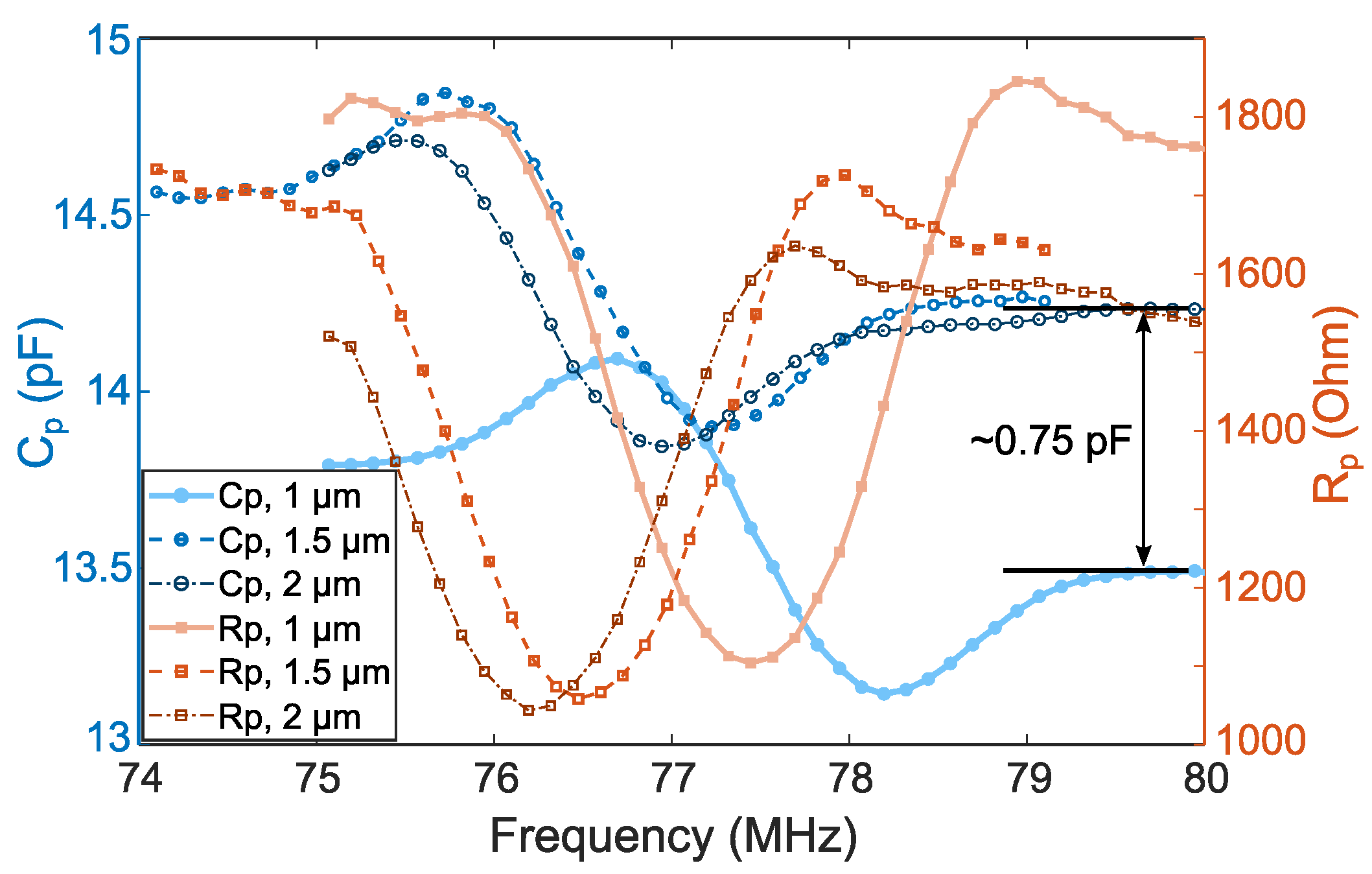
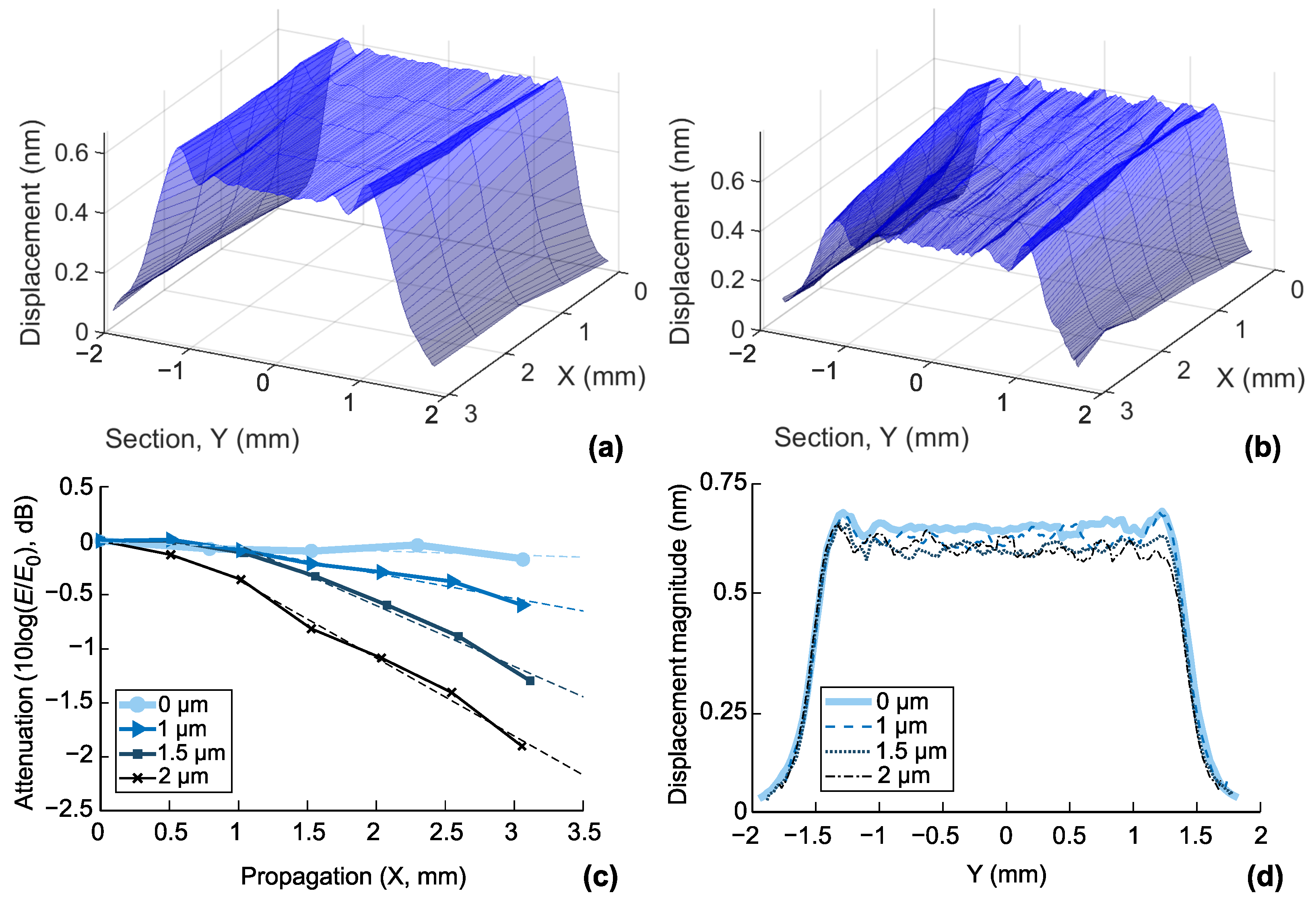
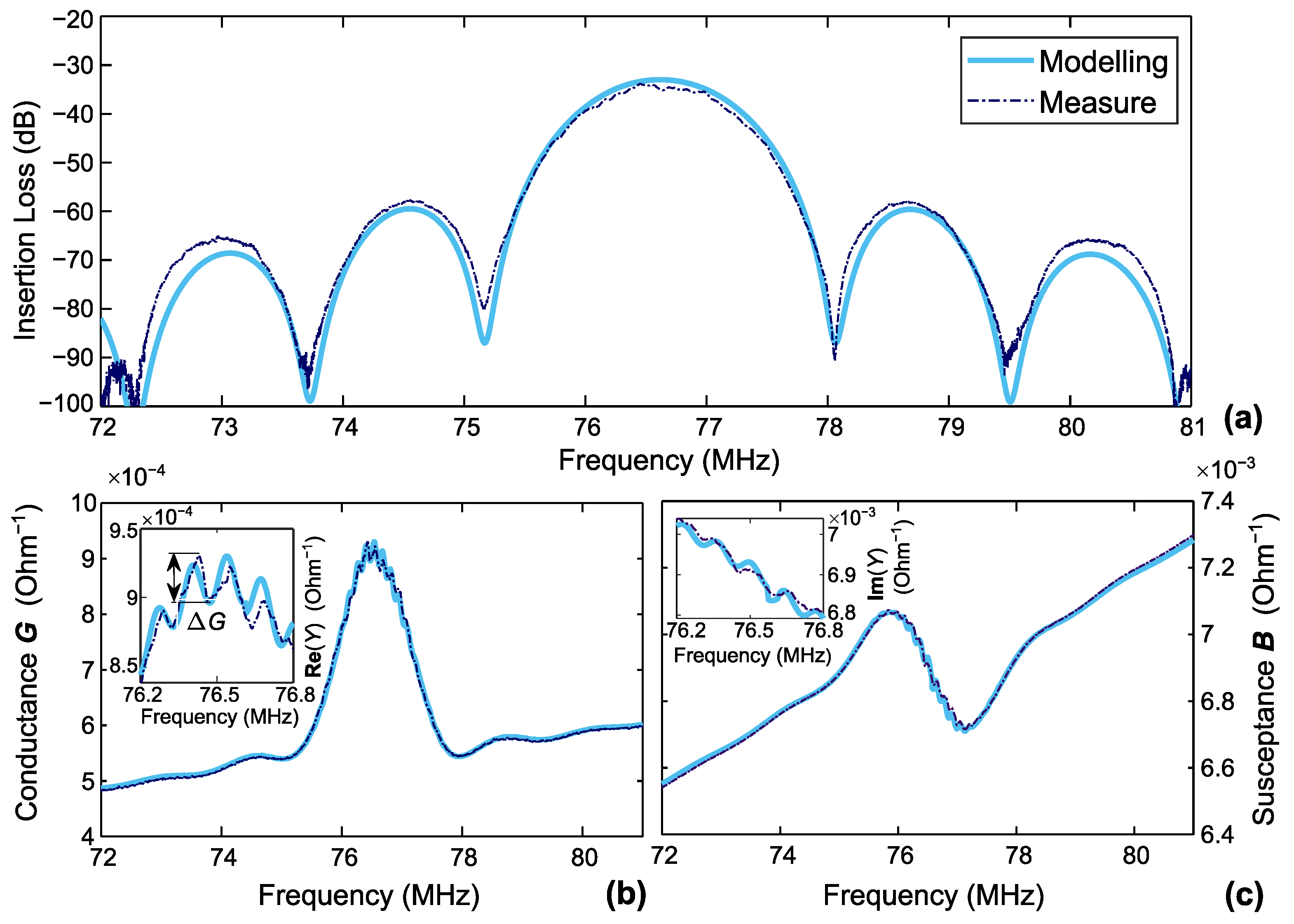
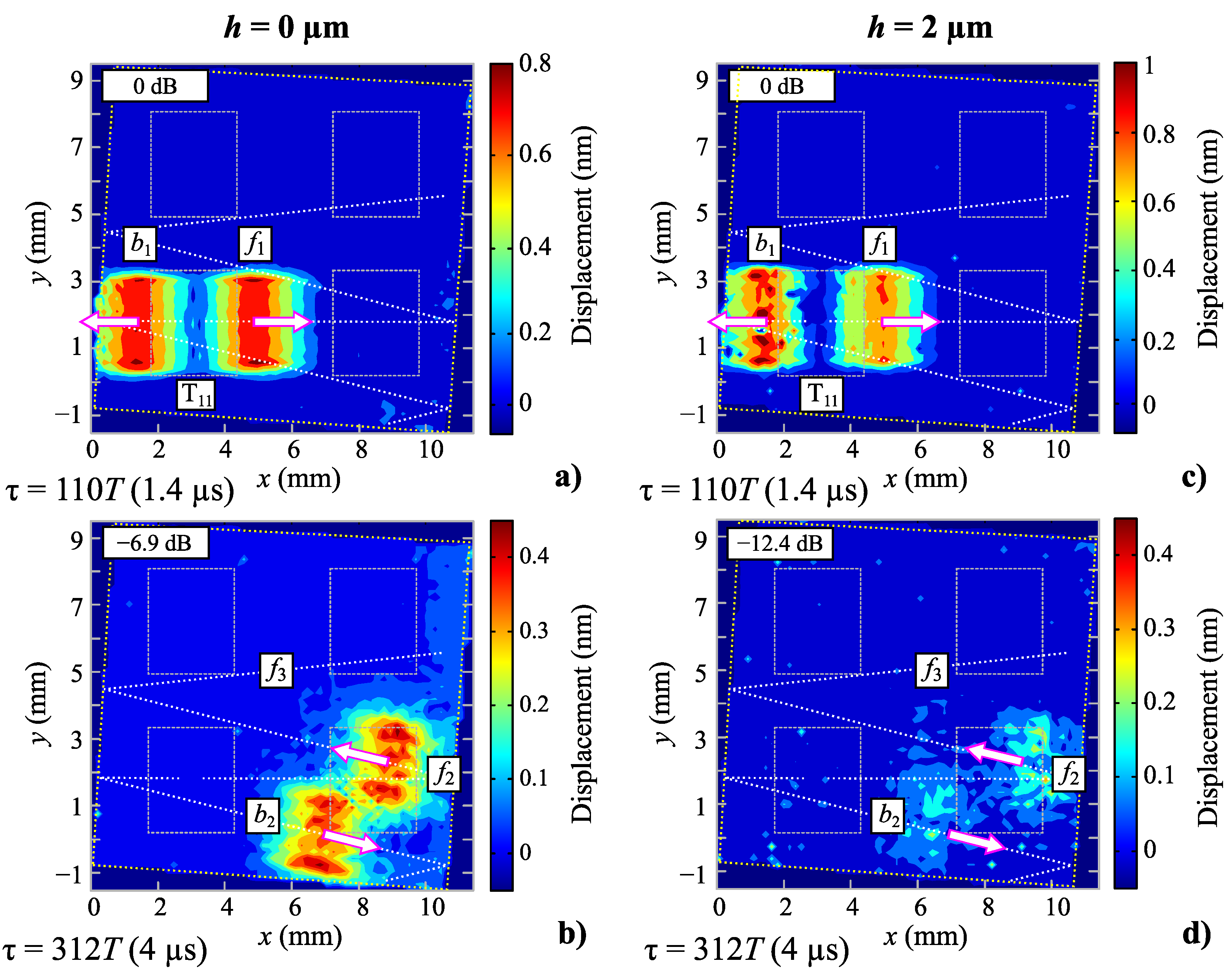

| Sensor | Central | Relative | Insertion | Increase of the Insertion | Crosstalk |
|---|---|---|---|---|---|
| Frequency (MHz) | Downshift (%) | Loss (dB) | Loss Value (dB) | (dB) | |
| Uncoated | 78.83 | n/a | n/a | ||
| Coated | |||||
| 1 µm | 77.55 | 1.6 | 1.28 | ||
| 1.5 µm | 76.64 | 2.7 | 2.88 | ||
| 2 µm | 76.24 | 3.28 | 3.9 |
| Parylene Thickness (µm) | Optical Loss (dB/mm) | RF Loss (dB/mm) | Difference |
|---|---|---|---|
| 0 | 0.04 | ... | ... |
| 1 µm | 0.23 | 0.29 | 0.06 |
| 1.5 µm | 0.56 | 0.59 | 0.03 |
| 2 µm | 0.72 | 0.79 | 0.07 |
| Thickness | VNA Frequency | Relative Shift | Velocity, IDT Free | Velocity, IDT | LDV Frequency | Relative Shift |
|---|---|---|---|---|---|---|
| (µm) | (MHz) | % | Space (m/s) | Region (m/s) | (MHz) | % |
| 0 µm | 78.83 | – | 3156 | 3153 | 78.83 | – |
| 1 µm | 77.55 | 1.6 | 3105 | 3102 | 77.55 | 1.6 |
| 1.5 µm | 76.64 | 2.7 | 3068 | 3065 | 76.63 | 2.79 |
| 2 µm | 76.24 | 3.28 | 3057 | 3051 | 76.27 | 3.25 |
| Parameters | 0 µm | 1 µm | 1.5 µm | 2 µm |
|---|---|---|---|---|
| (m/s) | 3153 | 3101 | 3065 | 3051 |
| (%) | 0.371 | 0.239 | 0.17 | 0.145 |
| 2.24 × 10 | 2.218 × 10 | 2.18 × 10 | 2.216 × 10 | |
| C (pF/µm) | 8.15 × 10 | 8.67 × 10 | 8.87 × 10 | 8.93 × 10 |
| 1.84 × 10 | 1.059 × 10 | 2.58 × 10 | 3.32 × 10 | |
| (Ohm) | n/a | 11.55 | 11.25 | 12.2 |
Publisher’s Note: MDPI stays neutral with regard to jurisdictional claims in published maps and institutional affiliations. |
© 2022 by the authors. Licensee MDPI, Basel, Switzerland. This article is an open access article distributed under the terms and conditions of the Creative Commons Attribution (CC BY) license (https://creativecommons.org/licenses/by/4.0/).
Share and Cite
Smagin, N.; Vanotti, M.; Duquennoy, M.; Rousseau, L.; Alhousseini, H.; Blondeau-Patissier, V.; Ouaftouh, M.; Valbin, L.; Herth, E. Electrical and Optical Characterization of SAW Sensors Coated with Parylene C and Their Analysis Using the Coupling-of-Modes (COM) Theory. Sensors 2022, 22, 8611. https://doi.org/10.3390/s22228611
Smagin N, Vanotti M, Duquennoy M, Rousseau L, Alhousseini H, Blondeau-Patissier V, Ouaftouh M, Valbin L, Herth E. Electrical and Optical Characterization of SAW Sensors Coated with Parylene C and Their Analysis Using the Coupling-of-Modes (COM) Theory. Sensors. 2022; 22(22):8611. https://doi.org/10.3390/s22228611
Chicago/Turabian StyleSmagin, Nikolay, Meddy Vanotti, Marc Duquennoy, Lionel Rousseau, Hassan Alhousseini, Virginie Blondeau-Patissier, Mohammadi Ouaftouh, Laurie Valbin, and Etienne Herth. 2022. "Electrical and Optical Characterization of SAW Sensors Coated with Parylene C and Their Analysis Using the Coupling-of-Modes (COM) Theory" Sensors 22, no. 22: 8611. https://doi.org/10.3390/s22228611





